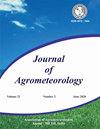基于天气变量使用统计和机器学习模型预测黄麻作物主要害虫的发病率:来自西孟加拉邦的案例研究
Q3 Agricultural and Biological Sciences
引用次数: 0
摘要
库奇贝哈尔种植的黄麻作物每年都会遭受大量的物理和经济损失,这是由于几种主要的害虫侵扰,如黄貂(Polyphagotarsonemus latus Banks)和黄麻半环虫(Anomis sabulifera Guen)。构建的季节性地块显示,黄貂害虫的发病率最高为55 DAS,而黄麻半环虫的发病率为45 DAS。相关分析表明,本周最低气温、滞后一周的最大相对湿度、滞后两周的最低气温、最小相对湿度和最大相对湿度等天气参数与黄颡鱼发病率显著相关,而在Jute Semilooper最高气温的情况下,滞后两周时的最小相对湿度与最大相对湿度显著相关。不同的预测模型,如ARIMA、ARIMAX、SARIMA、SARIMAX和SVR,已经使用RMSE值进行了拟合和验证。在Jute半活套的情况下,发现SARIMAX模型是最适合的模型,其次是SVR和SARIMA。类似地,对于黄貂,ARIMAX模型产生的RMSE值最小,其次是SVR和ARIMA。在成功验证模型后,使用最佳拟合模型对2022年进行预测。本文章由计算机程序翻译,如有差异,请以英文原文为准。
Prediction of major pest incidence in Jute crop based on weather variables using statistical and machine learning models: A case study from West Bengal
Jute crop cultivated in Cooch Behar suffers a substantial amount of physical and economical loss every year due to several major insect pest infestation such as Yellow Mite (Polyphagotarsonemus latus Banks) and Jute Semilooper (Anomis sabulifera Guen). Constructed seasonal plots reveal that for Yellow Mite pest incidence is maximum at 55 DAS, while for Jute Semi Looper it is at 45 DAS. Correlation analysis indicate that the weather parameters such as minimum temperature at current week, maximum RH at one week lag, minimum temperature, minimum and maximum RH at two week lag are significantly correlated with the incidence of Yellow Mite, while in case of Jute Semilooper maximum temperature, minimum and maximum RH at two week lag are significantly correlated. Different forecasting models like ARIMA, ARIMAX, SARIMA, SARIMAX and SVR have been fitted and validated using RMSE values. In case of Jute Semilooper, SARIMAX model is found to be the best fitted model followed by SVR and SARIMA. Similarly, for Yellow Mite ARIMAX model produces the least RMSE value followed by SVR and ARIMA. Following successful model validation, forecasting is done for the year 2022 using the best fitted models.
求助全文
通过发布文献求助,成功后即可免费获取论文全文。
去求助
来源期刊

Journal of Agrometeorology
农林科学-农艺学
CiteScore
1.40
自引率
0.00%
发文量
95
审稿时长
>12 weeks
期刊介绍:
The Journal of Agrometeorology (ISSN 0972-1665) , is a quarterly publication of Association of Agrometeorologists appearing in March, June, September and December. Since its beginning in 1999 till 2016, it was a half yearly publication appearing in June and December. In addition to regular issues, Association also brings out the special issues of the journal covering selected papers presented in seminar symposia organized by the Association.
 求助内容:
求助内容: 应助结果提醒方式:
应助结果提醒方式:


